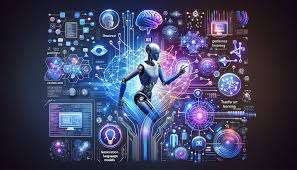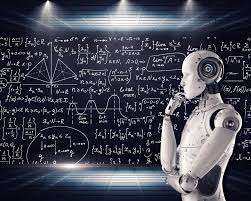Artificial intelligence (AI) is rapidly transforming our world, seeping into every facet of our lives from the way we work to how we interact with technology. As we race towards a future powered by AI, it’s crucial to understand the trends that are shaping this ever-evolving landscape. This blog delves into the most significant AI trends currently unfolding, offering insights into their potential impact and what they might hold for the years to come.

1. The Rise of Generative AI: From Art to Code, Creativity Unleashed
Generative AI refers to a category of AI models that can create entirely new content, including text, code, images, and even music. This technology utilizes deep learning algorithms trained on massive datasets to learn the underlying patterns and structures of various forms of creative expression. As a result, generative AI can produce strikingly realistic and innovative outputs.
Here are some exciting applications of generative AI:
- Art Generation: Generative AI is revolutionizing the art world, allowing artists to create stunning visuals and explore new artistic avenues. Programs like Dall-E 2 and Midjourney can generate images based on textual descriptions, pushing the boundaries of artistic creation.
- Content Creation: This technology has the potential to streamline content creation for businesses and individuals. Generative AI can be used to create realistic product descriptions, marketing copy, and even social media content, freeing up human resources for more strategic tasks. For video content creation specifically, tools like FlexClip AI video editor leverage generative AI to transform ideas into engaging videos in a matter of minutes.
- Software Development: Generative AI can assist programmers by automatically generating code snippets or even entire programs based on specific requirements. This could significantly speed up the development process and minimize the risk of errors.
2. Democratization of AI: Making Powerful Tools Accessible to All
Traditionally, AI development required significant expertise and resources. However, a growing trend is the democratization of AI, making it accessible to a wider range of individuals and businesses. This is primarily driven by the emergence of:
- Cloud-based AI Services: Cloud platforms like Google Cloud AI and Amazon Web Services (AWS) offer a plethora of pre-trained AI models and tools accessible through APIs. This allows users to leverage powerful AI capabilities without the need for extensive infrastructure or expertise.
- Low-code/No-code AI Tools: The development of user-friendly, low-code/no-code AI tools is further democratizing the field. These platforms empower users with limited coding experience to build basic AI applications and customize pre-existing models for their specific needs.
The democratization of AI holds immense potential for various sectors. It can empower small businesses to compete with larger companies by offering access to advanced AI capabilities. Additionally, it fosters innovation by allowing a wider range of individuals to experiment and develop novel AI-powered solutions.
3. The Growing Importance of Explainable AI (XAI)
As AI models become increasingly complex, ensuring their transparency and accountability is paramount. This is where Explainable AI (XAI) comes into play. XAI techniques aim to make the internal workings of AI models more understandable, allowing humans to grasp how these models arrive at decisions and conclusions.
Here’s why XAI is crucial:
- Building Trust: By understanding how AI models function, users can develop greater trust in their outputs and feel confident in relying on them for critical decisions.
- Identifying Biases: XAI techniques can help uncover potential biases within AI models, allowing developers to mitigate them and ensure fairer outcomes.
- Regulation and Compliance: As AI becomes more integrated into society, regulations will likely become stricter. XAI will play a vital role in ensuring AI systems comply with these regulations and meet ethical standards.
The development and adoption of XAI techniques will be critical for ensuring the responsible development and deployment of AI in the future.
4. The Convergence of AI and Robotics: Shaping the Future of Automation
The fusion of AI and robotics is paving the way for a new generation of intelligent machines. By equipping robots with advanced AI capabilities, we can create machines that can learn, adapt, and operate in dynamic environments. This convergence has the potential to revolutionize various fields, including:
- Manufacturing: Intelligent robots powered by AI can automate complex tasks in factories, improving efficiency and productivity.
- Logistics and Warehousing: AI-powered robots can optimize warehouse operations, automate packaging and sorting processes, and streamline logistics networks.
- Healthcare: Robotic surgery assisted by AI is already improving surgical precision and patient outcomes.
The convergence of AI and robotics brings significant benefits, but it also raises ethical concerns about job displacement and the potential misuse of these technologies. As we move forward, addressing these concerns and developing responsible implementation strategies will be crucial.
5. The Focus on Human-AI Collaboration: Augmenting, not Replacing, Human Potential
One of the most crucial AI trends is the growing emphasis on human-AI collaboration. AI is not designed to replace humans, but rather to augment our capabilities and empower us to achieve more. By leveraging the strengths of both humans and machines, we can create a powerful synergy that drives innovation and progress.

Here’s how human-AI collaboration can be beneficial:
- Enhanced Decision-Making: AI can analyze vast amounts of data and identify patterns that humans might miss, providing valuable insights that can inform better decision-making.
- Increased Productivity: AI can automate repetitive tasks, freeing up human time and resources for more strategic endeavors.
- Unlocking Human Creativity: AI can assist with tasks such as brainstorming, idea generation, and content creation, allowing humans to focus on the more creative aspects of work.
As we move forward, fostering effective human-AI collaboration will be key. This requires developing user interfaces that facilitate seamless interaction between humans and AI systems, as well as investing in training programs that equip individuals with the skills necessary to work effectively alongside AI.
6. The Ethical Considerations of AI: Addressing Bias and Ensuring Responsible Development
The rapid advancement of AI necessitates careful consideration of the ethical implications. Here are some key areas of concern:
- Algorithmic Bias: AI models are trained on data sets that may reflect societal biases. This can lead to discriminatory outcomes in areas like loan approvals, facial recognition software, and recruitment processes. Mitigating algorithmic bias requires careful selection of training data and the implementation of fairness checks throughout the development process.
- Job displacement: Automation powered by AI is transforming industries and job markets. While AI will create new opportunities, it’s crucial to address the potential for job displacement and develop strategies to support workers who might be impacted.
- The Explainability Challenge: Ensuring the transparency and accountability of AI models remains a challenge. As discussed earlier, XAI (Explainable AI) techniques are crucial to gaining user trust and ensuring responsible AI development.
Addressing these ethical considerations will be vital for building public trust in AI and ensuring its positive impact on society.
7. The Evolving Landscape of AI Regulation: Balancing Innovation with Safety
As AI becomes more integrated into our lives, establishing robust regulatory frameworks is critical. Governments and regulatory bodies are grappling with the challenges of balancing innovation and economic growth with safety and ethical considerations.
Here are some aspects that AI regulations might address:
- Data privacy: Regulations might mandate responsible data collection, storage, and usage practices to protect user privacy.
- Algorithmic bias: Regulatory frameworks might establish guidelines to minimize bias in AI models and ensure fairness in their applications.
- Safety and security: Regulations might address the safety and security implications of AI systems, particularly in industries like autonomous vehicles and healthcare.
The development of comprehensive AI regulations will be a complex and ongoing process. International collaboration between governments will be crucial to ensure consistent and effective regulatory frameworks.
8. The Rise of AI for Good: Harnessing AI to Address Global Challenges
AI has immense potential to address some of the most pressing challenges facing our planet, from climate change and poverty to healthcare and education. Here are some ways AI can be utilized for good:
- Sustainability: AI can be used to optimize energy usage, develop cleaner energy sources, and monitor environmental changes to mitigate the effects of climate change.
- Global Health: AI can be utilized to analyze medical data, develop personalized treatment plans, and support early disease detection and prevention efforts.
- Education: AI-powered tutoring systems can personalize learning experiences for students, catering to individual learning styles and needs. AI can also be used to automate administrative tasks and free up educators to focus on providing individualized instruction.
By harnessing the power of AI for good, we can create a more sustainable, equitable, and prosperous future for all.
Conclusion: Embracing the Future of AI with a Human-Centered Approach
The field of AI is constantly evolving, and the trends discussed above represent just a glimpse into the exciting possibilities that lie ahead. As we embrace AI and integrate it further into our lives, it’s crucial to maintain a human-centered approach. By prioritizing responsible development, fostering collaboration between humans and AI, and addressing ethical concerns, we can ensure that AI serves as a powerful tool for positive change and progress.
More on:
- Human Potential: The Building Blocks of Intelligence: Machine Learning and Deep Learning
- Nature’s Nexus: The Ultimate Guide to Eco-Friendly Products
- A Glimpse into The Future: The Top Artificial Intelligence Trends
- FlexClip: Simplifying Video Creation for Everyone
- Navigating the Future of AI Content in Museums